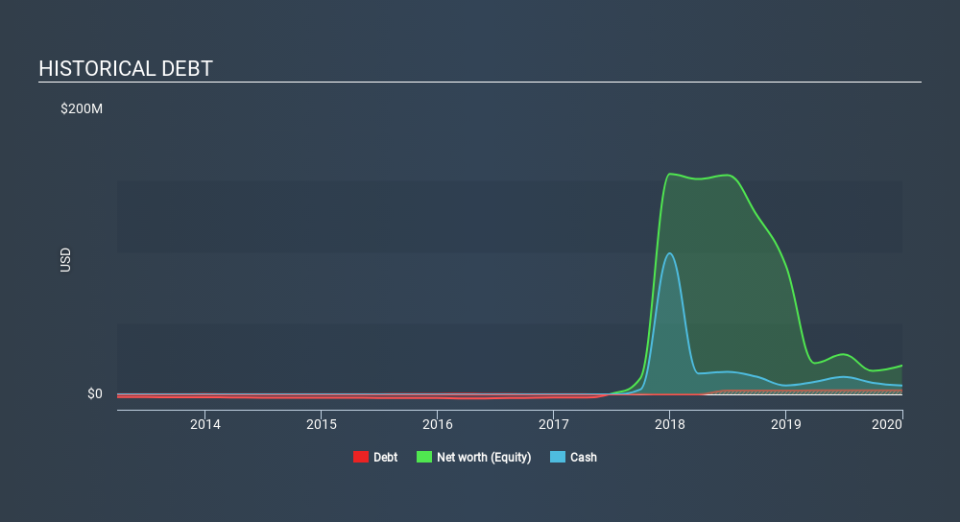HIVE Blockchain Technologies (CVE:HIVE) Has Debt But No Earnings; Should You Worry?

Warren Buffett famously said, 'Volatility is far from synonymous with risk.' So it seems the smart money knows that debt - which is usually involved in bankruptcies - is a very important factor, when you assess how risky a company is. As with many other companies HIVE Blockchain Technologies Ltd. (CVE:HIVE) makes use of debt. But the real question is whether this debt is making the company risky.
When Is Debt Dangerous?
Debt assists a business until the business has trouble paying it off, either with new capital or with free cash flow. Part and parcel of capitalism is the process of 'creative destruction' where failed businesses are mercilessly liquidated by their bankers. While that is not too common, we often do see indebted companies permanently diluting shareholders because lenders force them to raise capital at a distressed price. By replacing dilution, though, debt can be an extremely good tool for businesses that need capital to invest in growth at high rates of return. The first thing to do when considering how much debt a business uses is to look at its cash and debt together.
See our latest analysis for HIVE Blockchain Technologies
What Is HIVE Blockchain Technologies's Net Debt?
You can click the graphic below for the historical numbers, but it shows that as of December 2019 HIVE Blockchain Technologies had US$2.97m of debt, an increase on US$2.79m, over one year. But on the other hand it also has US$6.19m in cash, leading to a US$3.21m net cash position.
A Look At HIVE Blockchain Technologies's Liabilities
According to the last reported balance sheet, HIVE Blockchain Technologies had liabilities of US$5.67m due within 12 months, and liabilities of US$290.9k due beyond 12 months. On the other hand, it had cash of US$6.19m and US$7.64m worth of receivables due within a year. So it can boast US$7.87m more liquid assets than total liabilities.
It's good to see that HIVE Blockchain Technologies has plenty of liquidity on its balance sheet, suggesting conservative management of liabilities. Because it has plenty of assets, it is unlikely to have trouble with its lenders. Simply put, the fact that HIVE Blockchain Technologies has more cash than debt is arguably a good indication that it can manage its debt safely. When analysing debt levels, the balance sheet is the obvious place to start. But it is HIVE Blockchain Technologies's earnings that will influence how the balance sheet holds up in the future. So when considering debt, it's definitely worth looking at the earnings trend. Click here for an interactive snapshot.
Over 12 months, HIVE Blockchain Technologies made a loss at the EBIT level, and saw its revenue drop to US$32m, which is a fall of 8.3%. That's not what we would hope to see.
So How Risky Is HIVE Blockchain Technologies?
Statistically speaking companies that lose money are riskier than those that make money. And the fact is that over the last twelve months HIVE Blockchain Technologies lost money at the earnings before interest and tax (EBIT) line. And over the same period it saw negative free cash outflow of US$1.3m and booked a US$73m accounting loss. While this does make the company a bit risky, it's important to remember it has net cash of US$3.21m. That means it could keep spending at its current rate for more than two years. Overall, its balance sheet doesn't seem overly risky, at the moment, but we're always cautious until we see the positive free cash flow. When analysing debt levels, the balance sheet is the obvious place to start. But ultimately, every company can contain risks that exist outside of the balance sheet. For instance, we've identified 6 warning signs for HIVE Blockchain Technologies (2 are significant) you should be aware of.
At the end of the day, it's often better to focus on companies that are free from net debt. You can access our special list of such companies (all with a track record of profit growth). It's free.
If you spot an error that warrants correction, please contact the editor at editorial-team@simplywallst.com. This article by Simply Wall St is general in nature. It does not constitute a recommendation to buy or sell any stock, and does not take account of your objectives, or your financial situation. Simply Wall St has no position in the stocks mentioned.
We aim to bring you long-term focused research analysis driven by fundamental data. Note that our analysis may not factor in the latest price-sensitive company announcements or qualitative material. Thank you for reading.

 Yahoo Finance
Yahoo Finance 
